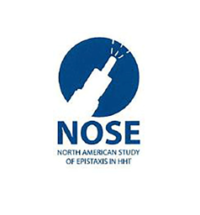North American Study of Epistaxis (NOSE Study)

Principal Investigator: Dr. James Gossage, Cure HHT Medical Director
Proposed Research Study
Overview – Cure HHT has been listening to its members and over the last two years, the largest clinical study to date involving several North American HHT Centers of Excellence has been carefully designed. The North American Therapeutics Group (NATG), led by Dr. James Gossage, conducted a systematic review of published research published on different nosebleed therapies. The group had a list of agents that was honed down to a study of three and a placebo. The U.S. Federal Drug Administration (FDA) reviewed the application and asked for testing to ensure the agents were safe and stable in the spray bottles. The agents were tested and Cure HHT received approval from the FDA.
This will be the largest multi-centered study of nosebleed treatment ever conducted and will be funded by members who have donated through the years to a special Epistaxis Fund.
Purpose – To carefully examine the benefit and safety of 3 nasal sprays for patients with HHT related epistaxis and definitively determine which of these are overall beneficial. Each of these sprays will approach the problem from a different mechanism of action. 140 patients with moderate to severe nosebleeds secondary to HHT, will be randomized to receive one of four intranasal sprays for a period of 12 weeks and then followed for an additional 12 weeks off therapy. A placebo arm has been included to allow an accurate estimate of both benefit and safety. The primary measure of effectiveness will be the frequency of epistaxis. Other measures of effectiveness will include the Hoag Epistaxis Severity Score (ESS), a quality of life survey, satisfaction with treatment, hemoglobin level, and transfusion requirements.
The spray agents included in the study are:
- Saline spray (Placebo);
- Estriol (a low dose estrogen);
- Tranexamic acid (a drug that promotes clotting), and
- Bevacizumab (also known as Avastin, a drug that might actually reverse abnormal blood vessel growth). The dose that will be used in the NOSE Study is 4mg per day, about 1% as potent as the intravenous dose. We expect that side effects will be minimal.
Research Study Update
The North American Study of Epistaxis in HHT completed enrollment with the last patient having been evaluated in July 2014. Between August 2011 and March 2014, Cure HHT enrolled 121 patients at six of the US HHT Centers of Excellence.
Interest in the treatment was actually so high that enrollment was slowed because patients were concerned about being placed on placebo. If it hadn’t been apparent before, this observation further confirmed how important research is to finding treatments and a cure for our community.
The complete results of the NOSE Study can be read in the Journal of American Medical Association (JAMA).
Cure HHT is very grateful to the members who have contributed and continue to support this research. While it may appear that this clinical trial has taken a long time to develop, it is important to recognize that it needs to be done with scientific rigor so that the results provide the important treatment information that is so needed in HHT. One key element of our mission is to advance therapeutic treatments for HHT patients.
The NATG Groups consists of the following members: James Gossage MD, Georgia Health Sciences University; Marie Faughnan MD, University of Toronto; Reed Pyeritz MD PhD, University of Pennsylvania; Paul Oh PhD, University of Florida; Michelle Letarte PhD, Toronto Hospital for Sick Children; Dennis Sprecher, MD, Cure HHT Board Member; Scott Olitsky, MD, Cure HHT Board Member; Marianne Clancy, Cure HHT Executive Director
